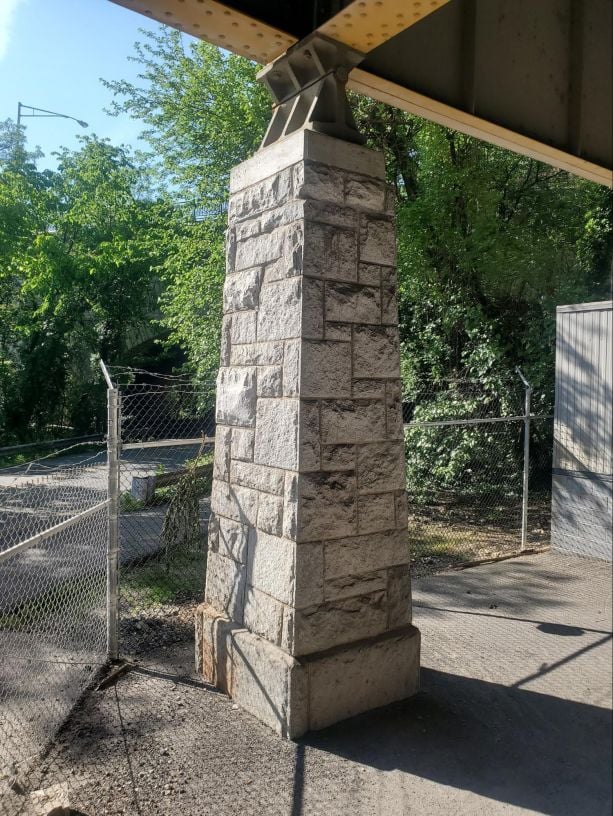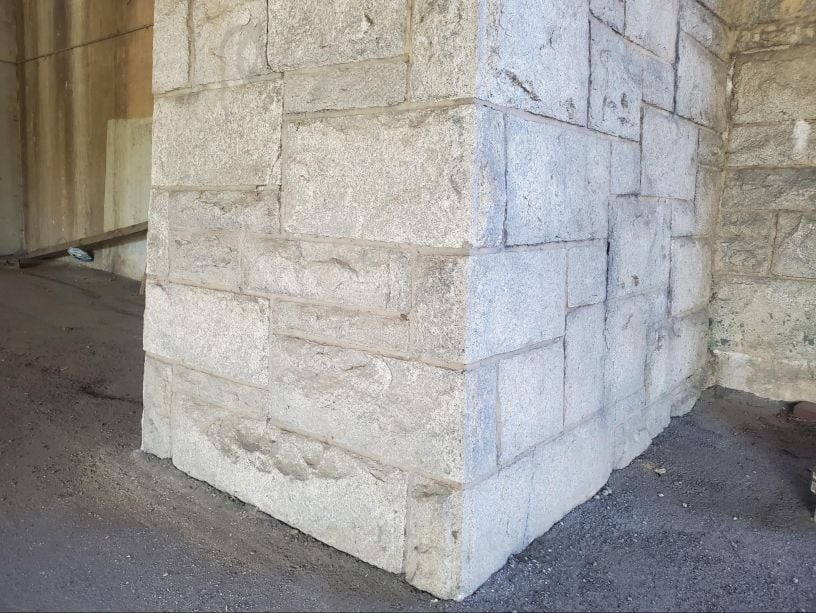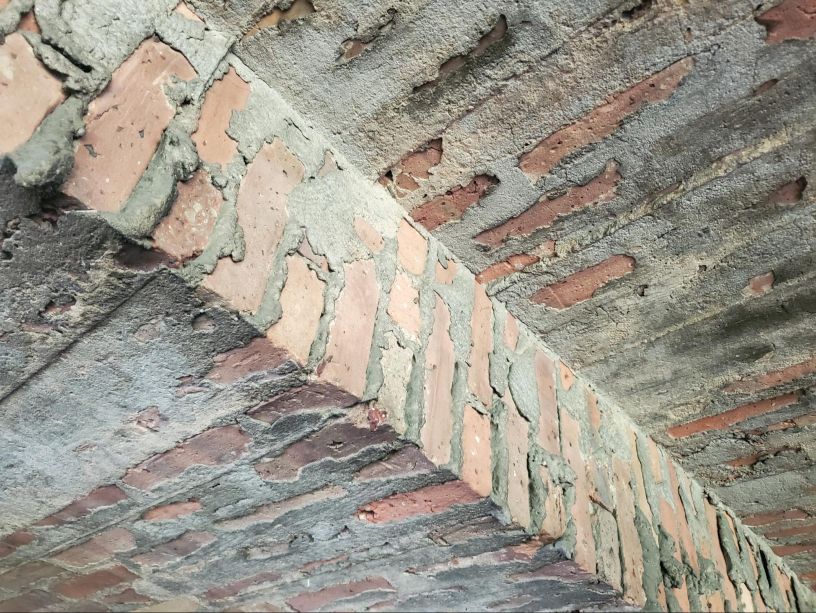Masonry Structural Piers and their importance in historic buildings
Masonry has been used to build structures for thousands of years, we can see the built environment, created with formations of masonry piers and walls, all around us in the city or urban environment.
Take a look back at an earlier blog on our site to learn about the history of and early uses of brick in the construction of the first civilizations on Earth.
Type of Loadpaths in Historic Buildings Around Washington, DC
Today we’re taking a look at a few different structures outside of the Washington, DC area to examine some of the types of load paths created with stone and brick masonry, and concrete in some cases. Masonry and concrete are particularly effective in building vertical load paths. Each of these types of materials has several similarities, and one of the most important of those characteristics is a very high compressive strength.
What is Compressive Strength
Compressive strength is essentially the ability for a material to withstand the force of being squished (to the point of failure) between two surfaces. In a masonry wall, for example, the vertical load of that wall downwards to the footing is a compressive strength that is squishing or forcing the material in the wall itself. In our discussions on historic masonry restoration, we often point out that the mortar of historic brick walls in Washington, DC have a lower compressive strength than modern masonry. Although the comparative strength is less for historic masonry, historic masonry still has very high compressive strength in terms of resistance to failure in a vertical load path.
Mortar Compatibility In Masonry Structural Piers
This topic, of mortar compatibility, comes up all the time in the discussion of historic mortar restoration in the tuckpointing or repointing process. Both names: repointing and tuckpointing (or sometimes just “pointing” or “point-up”) refer to restoring deteriorated historic brick mortar which is needed at all historic properties, in some cases multiple times, in the life of a building. Compatibility is essential, because newer mortars, used in the restoration process, must be compatible with the remaining substrate materials. Specifically, historic bricks, used in historic brick walls and other types of historic assemblies, were created in a lower temperature firing process. Because of the lower compressive strength of the constituent bricks, the mortar in a historic brick wall must have a compatible level of compressor strength and permeability. Permeability sounds like a different subject but generally the permeability and compressive strength of a mortar go hand-in-hand. The permeability becomes important because when a modern (high compressive strength) mortar is used in a historic wall, the newer less permeable mortar has a tendency to trap moisture behind the newly repointed or tuckpointed portion of the mortar joints of the wall. This problem occurs so frequently that it is clear, based on seeing the high number of improperly pointed buildings, that most masons working in the historic neighborhoods of Washington, DC do not understand even the most basic principles of historic restoration.
The picture below shows an ashlar granite stone pier. The stones are set in a mortar, similar to a brick mortar, with slightly larger joints. A taper is noticeable, the base of the column is significantly larger than the top of the column.
Looking at another nearby column, part of the same structure, you can see that the base of this column is also larger than the upper portions of the structural load bath. This taper or increasing size towards the lower base of a column is very common and repeated in almost all elements of building construction. In Capitol Hill, and the majority of Washington DC, for example, foundation walls were historically often built with a triple wythe or three brick thickness. The upper walls come including the demising walls which create the exterior shell or the separation between buildings is often built with just 2 bricks, a double wythe assembly. (The word wythe refers to the thicknesses of brick widths within a wall.)
Even in larger columns, as shown here, also part of the same support structure which is built at a intermediary span, carrying a larger load, this column is much larger overall, but also has a similar taper where the base of the pier is thicker than the upper portions. The upper portions increasingly are built thinner. This thinning taper, decreasing in size or thickness as the wall continues upwards, is common because the compressive load, also often referred to as the buckling load to describe the engineering design constraint of failure, decreases as the column continues upwards. The compressive resistance, in this case, is similar to the resistance described in tensile strength, but in this case is particular to a compressive load. Sway bracing is used at other parts of the building, bearing against both columns, in this case and at wood framing assemblies in historic rowhomes, for example.
The particular columns, shown in the pictures above, are supporting a superimposing steel structure. The next picture below, by comparison shows a masonry platform, built with a graduated brick masonry arch. Brick masonry units are molded or fired in rectilinear shapes, usually rectangular, and the graduated curvature of the platform employs these constrained rectilinear forms, yet is built with interconnected bands of bricks to blend and surpass the traditional limitations of the simple brick materials.
The Shape of Mortar Joints – How They Matter
By looking closely at the shape of the mortar at each joint, you can see that there is a stark contrast between the mortar at the vertical sides and the horizontal bottom of the structure. The mortar joints at the bottom of each strip have a flat profile and the sides have a protruding profile of mortar. Mortar has basically oozed out and not been struck clean or set planar, flush or flat to the brick masonry vertical face.
There’s a reason for this difference, it’s a sign. Without even knowing as a matter of fact, the exact method of original construction, you can infer some of the methodology of the historic construction. The original brick was laid or set into a horizontal or curved form in this tapered or slight radius. Brick was then laid on to that form or platform and built in curved yet relatively horizontal strips. The original forms could have been set on structural scaffold, and before those scaffolds were removed, the scaffolding may have rendered the vertical sides of each brick strip inaccessible. For this reason, since the brick was set against a form, at the bottom of the brick, the mortar between each brick now has a flat facing. By comparison, the vertical sides of the brick are rough and not struck or finished.
In the next picture below, you can see the vertical face of the brickwork more closely. The mortar is oozed out of the mortar joints onto the face of the brick. When the bricks were set in place, excess mortar was applied to fill any potential voids between the head joint of the bricks. Each brick was then positioned more closely into its correct location, and that positioning caused the excess mortar to ooze out the of the interstitial space between each brick, and because the area next to the vertical face of the bricks was inaccessible that mortal was not able to be cleaned away. Now that mortar remains on the side of the bricks, to this day.
The next picture focuses on the horizontal bottom of the historic brickwork. Here you can see the mortar lays flat, even though at an inaccessible location, the mortar was pressed against the form work before the form work was stripped away.
Each strip of brickwork was Built-in succession, one next to the other creating an integral curved shape to support the nonlinear shape of the structure.
Curved Brickwork and Its Role
Unlike the piers, the curved shape of this structure transfers a load that spans from the center, back to the horizontal connection point with the ground on each side. This structure is built with a large span, using the tensile strength and transferring that tensile strength back to the compressive vertical load at the outer sides. The curve itself transitions the tensile load to a compressive load by putting each brick into a compressive position.
Concrete generally follows the same structural principles of brick or stone and mortar masonry. In the case of a retaining wall, the picture below provides a perfect cross-section view, an angle rarely seen in a retaining wall. In this case the side is open and you can see the front, back, and side of the retaining wall. Going up from the bottom, the wall was built consistently thinner towards the top. However, unlike the piers, this particular wall’s function is more related to tensile resistance, and reduction in thickness is although not for compressive load reasons, can be reduced due to a lower calculation or coefficient of repose, related to tensile force.
The retaining wall shows an example of how a reduction in upper structure thickness applies both across conditions of tensile and compressive load. A typical jersey wall, a concrete barrier used as a traffic ram barrier, is built in a similar way, but related to tensile resistance. The picture below shows an example of a heavy concrete jersey wall set aside in a construction yard, covered in graffiti.
How Thickness is Reduced in Structural Piers
At the edge of the Jersey barrier, the taper to reduce thickness at the top is visually apparent. The base is clearly thicker, not just for purposes of force resistance, but also for stabilization of the barrier. Making the top of the barrier thinner does not significantly limit or reduce the tensile resistance capacity or amount of structural resistance. However, making the barrier thinner at the top reduces the overall amount of concrete needed for manufacturing and assembly, but most importantly reduces the cost of transportation and the consumption of fuel in the process of transportation. This jersey wall, like a retaining wall, has a compressive resistance value but does not have an effective compressive load purpose. It does have to support its own weight (and the weight of other similar units in storage and transport), that particular type of load sounds unimportant, but materials like concrete and brick masonry are particularly heavy. Piers, by comparison are very different, in their functional purpose. Piers normally are built and used to support an imposed load directly above. Exterior building walls are similar. In the case of a historic brick rowhome in Washington, DC (and other similar historic cities in the USA, particularly along the Eastern Seaboard of the Atlantic), the exterior walls not only support themselves, but they also support the roof and floors of the building. Those floors also often support interior walls as well. In cases of home renovations in Washington, DC, clients often ask us if their walls are bearing or non-load-bearing. Bearing walls are an example of a wall that is engaged in the structural load path of the building. Non-bearing Walls though, by comparison, are entirely supported on the exterior walls. Even in cases where those non load-bearing walls do not sit on top of the exterior walls, they sit on floor joists which span between those walls and transfer the weight and load capacity from the interior of the building out, back to the exterior brick walls of the building.
In an upcoming followup article, we will talk specifically about historic brick masonry walls, associated repointing, tuckpointing and restoration and buttressed supports and designed tapers engineered to support the wall to resist deflection.
Maintaining Historic Buildings Properly
To properly maintain, repair, and care for these historic buildings, a knowledge, interest and understanding of historic building principles is required. Here in Washington DC, historic masonry buildings are extremely expensive and the amount of financial loss caused by improper repointing and low quality construction is staggering. However, in addition to the direct financial value of the property, there is also a cultural loss when historic buildings are damaged. By comparison, consider neighboring poor cities, when historic buildings are damaged, it’s not just the loss of value to the property owner, there’s also a loss to all inhabitants and visitors of a city, present and future, who care about architecture, history, and culture.
We encourage all of our clients, and all readers of this article and to our blog in general, to prioritize the historic built environment of Washington DC and neighborhoods such as Capitol Hill, Dupont Circle, and Georgetown and become educated on on the difference between proper historic preservation versus improper work which leads to significant damage to the historic fabric of a building.
From a conservation and preservation perspective, several approaches can be taken to improve conditions related to deteriorated historic brick masonry. Primarily, lime mortar brick joints and low temperature fired soft red clay bricks should be inspected and checked on a routine maintenance schedule, either seasonally or at least annually. If brick masonry is kept in good condition, the life of embedded wood elements can be significantly extended. Hire a professional contractor which specializes, understands and appreciates historic construction elements and buildings.
You can learn a lot more on our blog. Feel free to check it out. If you have questions about the historic masonry of your building in Washington DC, contact us or fill out the webform below and drop us a line. We will be in touch if we can help.












